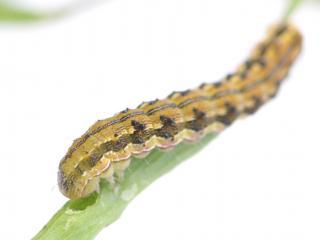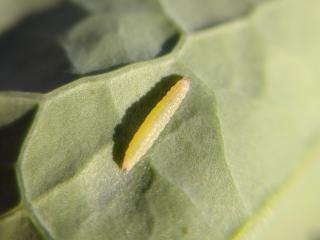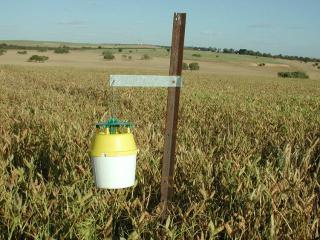Native budworm and diamondback moths are being found across the Wheatbelt
Native budworm and diamondback moth field reports
- Binnu
- Three Springs
Chris Pinkney (Agrarian) reports finding native budworm caterpillars up to 12mm long in budding lupin and canola crops in the Binnu area. A number of crops in the area have been sprayed to control the caterpillar numbers.
Chris has also found diamondback moth caterpillars (DBM) widespread from Binnu to Three Springs in canola crops that had received no post-emergent sprays. The caterpillars were mostly around 10mm in length indicating they are close to maturity and will soon be pupating. At this stage the numbers are relatively low, with not a lot of damage evident. The DBM caterpillars will be closely monitored over coming weeks and sprayed later in the season should they reach threshold damage levels. Their distribution within crops and between localities can vary greatly, hence the need for careful and regular monitoring of several areas within each crop.
The recommended thresholds for DBM caterpillar control are:
- pre-flowering (stressed crop) - 30 or more grubs per 10 sweeps
- pre-flowering (no stress) - 50 or more grubs per 10 sweeps.
Native budworm and diamondback moth trapping surveillance
- Binnu
- Dalwallinu
- Mukinbudin
- Northam
- Muresk
- Clackline
- Brookton
- Gibson
- Mt Ridley
Volunteer farmers, agronomists and some DPIRD staff will commence weekly pheromone trapping for native budworm moths in the coming weeks as part of a program to monitor the potential risk of native budworm caterpillars to pulse and canola crops.
Binnu budworm trapper Peter Cripps has put his budworm trap out early this year, given the recent reports of budworm flights, and this week captured 173 moths over 6 days.
High native budworm moth numbers have also recently been captured in automated traps set up in canola at Gibson (161) and Mount Ridley (92). No native budworm caterpillars were sweep netted in the trap canola crops and there wasn’t any significant damage from moths. However if this flight of moths has commenced egg laying in the crop it will take at least two to three weeks before they grow to a size of approximately 5mm long and can be detected whilst netting crops.
Smaller numbers of native budworm and diamondback moths have been reported in automated traps at Dalwallinu, Mukinbudin, Northam, Muresk, Clackline, Brookton and Merredin. The Merredin automated trap has recorded the most DBM moths with 24 captured. No DBM have been trapped near Albany yet.
Automated and manual native budworm moth trapping numbers will soon be available for viewing at the department’s Native budworm moth numbers 2020 page and will be displayed on cesar’s MothTrapVis page.
Pesticide options for the control of native budworm and DBM can be found in DPIRD’s Winter/Spring Insecticide Spray Chart 2019.
Detailed information on native budworm can be found at DPIRD’s Management and economic thresholds for native budworm page and 2020 PestFax Issue 7 article Native budworm and other moths are active.
For more DBM information refer to:
- DPIRD’s 2020 PestFax Issue 5 Diamondback moth caterpillars are in canola article
- DPIRD’s Diagnosing diamondback moth page
- GRDC's Diamondback moth fact sheet
- GRDC’s Managing diamondback moth video.
For more information contact Alan Lord, Technical Officer, South Perth +61 (0)8 9368 3758 or +61 (0)409 689 468.
Article authors: Alan Lord (DPIRD South Perth) and Cindy Webster (DPIRD Narrogin).
Sclerotinia apothecia are being found
-
Walkaway
-
Gibson (DPIRD’s Esperance Downs Research Station)
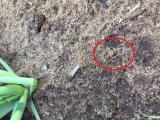
DPIRD officers Ciara Beard and Anne Smith have reported finding sclerotinia apothecia in a canola crop at Walkaway. The canola was at the cabbage stage (nine leaf) and the apothecia was found in a part of the paddock that was sown with lupins last year. The apothecia were light brown in colour, not the usual bright white they often come up as in the Geraldton area, indicating they have possibly been present for a week or more. Recent regular rain and cooler temperatures in the area will have suited their germination which signals the start of the sclerotinia cycle.
Sclerotia in a depot at the Esperance Downs Research Station (near Gibson) have also just started to germinate and produce apothecia.
These findings are a warning that the sclerotinia disease cycle is commencing in the northern and south coastal wheatbelt.
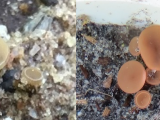
Apothecia are small cream-apricot coloured mushroom cups measuring 5-15mm in diameter that appear from the germination of sclerotia (hard black fruiting bodies/resting structures of sclerotinia) under favourable conditions. While they can vary somewhat in colour, they all tend to darken over time and can survive for around three weeks before withering away.
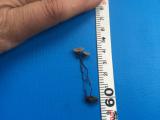
Carefully digging out the apothecia will usually show you its connection back to the sclerote it germinated from.
Apothecia release massive numbers of ascospores that cause sclerotinia stem rot predominantly via infecting petals in all broadleaf crops including canola, lupins, chickpeas, lentils, field peas, faba beans, lucerne and weeds (wild radish and cape weed). These infected petals fall into the crop canopy and under humid damp conditions can cause stem infection - this is the most common infection pathway. In some years, particularly under very wet conditions in paddocks that have high inoculum levels, basal infections pre-flowering have been observed. Basal stem infections can develop from infected leaves that touch the ground or direct growth over/under the soil from sclerotia to the stem. White masses that are fungal hyphae (on leaves, soil or stem bases) are the key symptom to look for.
Growers are urged to start planning for sclerotinia management in their canola crops.
Weather conditions seem to be favourable for sclerotinia spore release in some parts of the grainbelt and therefore elevating the risk for disease outbreaks in flowering canola.
DPIRD research over the past few years has shown that as a rule of thumb regular rainfall and high humidity (>75%) in the three weeks before and after commencement of flowering are most conducive for the damaging levels of disease to occur in crops. Although canola crops are at variable growth stages in the state, the most vulnerable canola crops are the ones that have just started to flower or are flowering. These may require fungicide protection.
Growers need to consider the following factors to determine their risk of sclerotinia:
- rotation history of the paddock
- history of sclerotinia in the current canola and surrounding paddocks
- rainfall events before and after flowering
- growth stage of canola.
A new tool is available for use during crop flowering to help growers/consultants determine the likely economic returns from applying fungicide at a specific time during flowering. DPIRD’s free SclerotiniaCM app can aid in fungicide decision making once the crop is in the early bloom stage. The app uses a forecasting model and the user can specify individual paddock data/history as well as recent and expected weather conditions so that the output relates to their own cropping circumstances. The SclerotiniaCM app can be downloaded from the App Store or Google Play Store onto your iPad or Android tablet. For more information refer to DPIRD’s SclerotiniaCM app page.
Several fungicide products that are made up of the active ingredients prothioconazole + tebuconazole, procymidone, iprodione, prothioconazole + bixafen and more recently azoxystrobin + tebuconazole are registered for the control of sclerotinia in canola. Fungicides need to be applied as recommended per product label.
Based on the extensive research conducted by DPIRD over the last few years the following in-season sclerotinia management options are recommended:
- Apply a single foliar application at 30-50% bloom, provided conditions are favourable for infection before and during flowering. See Table 1 below for recognising bloom stages in canola. Use the SclerotiniaCM app for guidance.
- A second fungicide application at 50% (full) bloom is only beneficial in seasons with an extended wet period. Use the SclerotiniaCM app for guidance.
- If growers notice ground infections they can apply a foliar fungicide immediately or wait until 20% bloom to prevent further new infections.
- Fungicide application is still warranted in crops with wide row spacing (up to 44cm) if the seasonal conditions (high rainfall and humidity) become favourable during flowering.
| Percent bloom | Number of flowers open on the main stem |
|---|---|
| 5% | <5 |
| 10% | 10 |
| 20% (petal drop commences) | 11-14 |
| 30% | 15-20 |
| 50% | >20 |
Growers and consultants are encouraged to report to the PestFax service any apothecia finds or disease observations as the season progresses.
Further information can be found at the department’s Managing sclerotinia stem rot in canola page and GRDC’s Sclerotinia stem rot in canola fact sheet.
For more information on sclerotinia contact plant pathologists Ciara Beard, Geraldton on +61 (0)8 9956 8504 or Andrea Hills, Esperance on +61 (0)8 9083 1144.
Article authors: Ciara Beard (DPIRD Geraldton), Jean Galloway (DPIRD Northam) and Andrea Hill (DPIRD Esperance).

